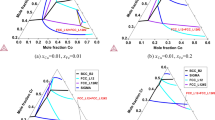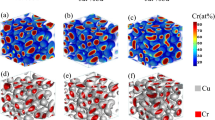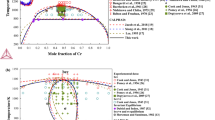Abstract
Quinary phase-field model was extended and constructed, and the diffusion-controlled phase decomposition and morphology in thermal aging Fe–Cu–Mn–Ni–Al quinary system coupled with CALPHAD thermodynamic databases were successfully studied. The effects of Manganese composition on the morphology, volume fraction, number density, particles size and growth and coarsening of Cu-rich precipitates were investigated systematically. The simulation results showed that Cu-rich α phase was firstly formed, and the Ni, Al and Mn atoms were partitioned to the Cu-rich phase, leading to the formation of a Ni–Al–Mn-rich intermetallic ring/Cu-rich core precipitate morphology and final conversion of Cu-rich phase to Cu-rich γ phase. The curves of volume fraction and free energy variation with simulation time indicated that Mn element can promote nucleation driving force to overcome the nucleation barrier in initial stage and can also accelerate the precipitation of Cu-rich phase and promote the growth and coarsening processes. Through the analysis of number density (ND) and average particle size (APS), we found that the values of ND and APS of Cu-rich particles increase with the rising of Mn content, which indicates that the higher Mn content will boost the nucleation and growth rate. Moreover, the time exponent at the later precipitation was 0.41, 0.42 and 0.37, respectively, which had deviations with the 0.33 of the LSW’s value, and the growth and coarsening of Cu-rich precipitates were under the mixed mechanisms of Ostwald ripening and coalescence coarsening of neighboring precipitates. These results provided useful information for the preparation of multi-component alloyed steel with excellent mechanical properties to some extent.








Similar content being viewed by others
References
Kamada Y, Takahashi S, Kikuchi H, Kobayashi S, Ara K, Echigoya J, Tozawa Y, Watanabe K (2009) Effect of pre-deformation on the precipitation process and magnetic properties of Fe–Cu model alloys. J Mater Sci 44:949–953. https://doi.org/10.1007/s10853-008-3182-0
Shu S, Wirth BD, Wells PB, Morgan DD, Odette GR (2018) Multi-technique characterization of the precipitates in thermally aged and neutron irradiated Fe-Cu and Fe-Cu-Mn model alloys: atom probe tomography reconstruction implications. Acta Mater 146:237–252
Wen YR, Hirata A, Zhang ZW, Fujitaa T, Liu CT, Jiang JH, Chen MW (2013) Microstructure characterization of Cu-rich nanoprecipitates in a Fe-2.5Cu-1.5Mn-4.0Ni-1.0Al multicomponent ferritic alloy. Acta Mater 61:2133–2147
Rahnama A, Dashwood R, Sridhar S (2017) A phase-field method coupled with CALPHAD for the simulation of ordered κ-carbide precipitates in both disordered γ and α phases in low density steel. Comput Mater Sci 126:152–159
Jiao ZB, Luan JH, Miller MK, Chung YW, Liu CT (2016) Co-precipitation of nanoscale particles in steels with ultra-high strength for a new era. Mater Today 20:142–154
Chi CY, Yu HY, Dong JX, Liu WQ, Cheng SC, Liu ZD, Xie XS (2012) The precipitation strengthening behavior of Cu-rich phase in Nb contained advanced Fe–Cr–Ni type austenitic heat resistant steel for USC power plant application. Prog Nat Sci 22:175–185
Shen Q, Xiong XY, Li T, Chen H, Cheng YM, Liu WQ (2018) Effects of co-addition of Ni and Al on precipitation evolution and mechanical properties of Fe–Cu alloy. Mater Sci Eng, A 723:279–286
Zhang ZW, Liu CT, Wang XL, Miller MK, Ma D (2012) Effects of proton irradiation on nanocluster precipitation in ferritic steel containing fcc alloying additions. Acta Mater 60:3034–3046
Soisson F, Barbu A, Martin G (1996) Monte Carlo simulations of copper precipitation in dilute iron-copper alloys during thermal ageing and under electron irradiation. Acta Mater 44:3789–3800
Biner SB, Rao W, Zhang Y (2015) The stability of precepitates and the role of lattice defects in Fe-1at%Cu-1at%Ni-1at%Mn alloy: a phase-field model study. J Nucl Mater 468:9–16
Jiao ZB, Luan JH, Miller MK, Liu CT (2015) Precipitation mechanism and mechanical properties of an ultra-high strength steel hardened by nanoscale NiAl and Cu particles. Acta Mater 97:58–67
Cao L, Wu S, Liu B (2013) On the Cu precipitation behavior in thermo-mechanically embrittlement processed low copper reactor pressure vessel model steel. Mater Design 47:551–556
Zhang Z, Liu CT, Miller MK, Wang XL, Wen YR, Fujita T, Hirata A, Chen MW, Chen G, Chin BA (2013) A nanoscale co-precipitation approach for property enhancement of Fe-base alloys. Sci Rep 3:1327
Eckert J, Holzer JC, Johnson WL (1993) Thermal stability and grain growth behavior of mechanically alloyed nanocrystalline Fe–Cu alloys. J Appl Phys 73:131–141
Isheim D, Kolli RP, Fine ME, Seidman DN (2006) An atom-probe tomographic study of the temporal evolution of the nanostructure of Fe–Cu based high-strength low-carbon steels. Scripta Mater 55:35–40
Kolli RP, Seidman DN (2007) Comparison of compositional and morphological atom-probe tomography analyses for a multicomponent Fe–Cu steel. Microsc Microanal 13:272–284
Osamura K, Okuda H, Takashima M, Asono K, Furusak AM (1993) Small-angle neutron scattering study of phase decomposition in Fe–Cu binary alloy. Mater Trans 34:305–311
Othen PJ, Jenkins ML, Smith GDW, Phythian WJ (1991) Transmission electron microscope investigations of the structure of copper precipitates in thermally-aged Fe–Cu and Fe–Cu–Ni. Philos Mag Lett 64:383–391
Vaynman S, Isheim D, Kolli RP, Bhat SP, Seidman DN (2008) High-strength low-carbon ferritic steel containing Cu–Fe–Ni–Al–Mn precipitates. Metall Mater Transa A 39:363–373
Miller MK, Wirth BD, Odette GR (2003) Precipitation in neutron-irradiated Fe–Cu and Fe–Cu–Mn model alloys: a comparison of APT and SANS data. Mater Sci Eng, A 353:133–139
Zhang C, Enomoto M (2006) Study of the influence of alloying elements on Cu precipitation in steel by non-classical nucleation theory. Acta Mater 54:4183–4191
Osamura K, Okuda H, Asano K, Furusaka M, Kishida K, Kurosawa Uemori R (1994) SANS study of phase decomposition in Fe–Cu alloy with Ni and Mn addition. Trans Iron Steel Inst Jpn 34:346–354
Xu G, Chu DF, Cai LL, Zhou BX, Wang W, Peng JC (2011) Investigation on the precipitation and structural evolution of Cu-rich nanophase in RPV model steel. Acta Metall Sin 47:905–911
Jiao ZB, Luan JH, Miller MK, Yu CY, Liu Y, Liu CT (2016) Precipitate transformation from NiAl-type to Ni2AlMn-type and its influence on the mechanical properties of high-strength steels. Acta Mater 110:31–43
Rawlings MJS, Liebscher CH, Asta M, Dunand DC (2017) Effect of titanium additions upon microstructure and properties of precipitation-strengthened Fe–Ni–Al–Cr ferritic alloys. Acta Mater 128:103–112
Kolli RP, Seidman DN (2014) Co-precipitated and collocated carbides and Cu-rich precipitates in a Fe–Cu steel characterized by atom-probe tomography. Microsc Microanal 2014:1727–1739
Kolli RP, Mao Z, Seidman DN, Keane DT (2007) Identification of a Ni0.5(Al0.5−xMnx)B2 phase at the heterophase interfaces of Cu-rich precipitates in an α-Fe matrix. Appl Phys Lett 91:241903
Vincent E, Becquart CS, Pareige C, Pareige P, Domain C (2008) Precipitation of the FeCu system: a critical review of atomic kinetic Monte Carlo simulations. J Nucl Mater 373:387–401
You LJ, Hu LJ, Xie YP, Zhao SJ (2016) Influence of Cu precipitation on tensile properties of Fe–Cu–Ni ternary alloy at different temperatures by molecular dynamics simulation. Comput Mater Sci 118:236–244
Chen LQ (2002) Phase-field models for microstructure evolution. Annu Rev Mater Res 32:113–140
Zhao P, Shen C, Li J, Wang Y (2017) Effect of nonlinear and noncollinear transformation strain pathways in phase-field modeling of nucleation and growth during martensite transformation. Npj Comput Mater 3:19
Sun YY, Zhao YH, Hou H, Zheng XJ, Guo HJ (2018) Microscopic phase-field simulation for the influence of aging process on the precipitation process of Ni75Al15Ti10 alloy. Rare Metal Mat Eng 47:3000–3007
Li Y, Hu S, Sun X, Stan M (2017) A review: applications of the phase field method in predicting microstructure and property evolution of irradiated nuclear materials. Npj Comput Mater 3:16
Miyoshi E, Takaki T, Ohno M, Shibuta Y, Sakane S, Shimokawabe T, Aoki T (2017) Ultra-large-scale phase-field simulation study of ideal grain growth. Npj Comput Mater 3:25
Ma QS, Ma ZQ, Zhao YH, Yu LM, Liu CX, Guo QY, Hossain A, Shahriar MD, Alshehri AA, Yamauchi Y, Liu YC (2018) Inversion calculation of the interatomic potentials for Ni0.75AlxMo0.25−x alloy employing microscopic phase-field model. Sci Adv Mater 10:904–912
Zhang JB, Wang HF, Kuang WW, Zhang YC, Li S, Zhao YH, Herlach DM (2018) Rapid solidification of non-stoichiometric intermetallic compounds: modeling and experimental verification. Acta Mater 148:86–99
Koyama T, Onodera H (2005) Computer simulation of phase decomposition in Fe–Cu–Mn–Ni quaternary alloy based on the phase-field method. Mater Trans 46:1187–1192
Saunders N, Miodownik PA (1992) Calphad: calculation of phase diagrams: a comprehensive guide. Pergamon, Germany
Luo ZL, Du Y, Liu YL, Tang S, Pan Y, Mao H, Peng YB, Liu WS, Liu ZK (2018) Phase field simulation of the phase separation in the TiC-ZrC-WC system. Calphad 63:190–195
Dinsdale AT (1991) SGTE data for pure elements. Calphad 15:317–425
Koyama T, Onodera H (2006) Modeling of microstructure changes in Fe–Cr–Co magnetic alloy using the phase-field method. J Phase Equilib Diffus 27:22–29
Hillert M, Jarl M (1978) A model for alloying in ferromagnetic metals. Calphad 2:227–238
Li YS, Zhu H, Zhang L, Cheng XL (2012) Phase decomposition and morphology characteristic in thermal aging Fe–Cr alloys under applied strain: a phase-field simulation. J Nuc Mater 429:13–18
Koyama T, Hashimoto K, Onodera H (2006) Phase-field simulation of phase transformation in Fe–Cu–Mn–Ni quaternary alloy. Mater Trans 47:2765–2772
Metals data book, 3rd Ed., Japan Institute of Metals ed., Maruzen, Tokyo, Japan, 1993
Taylor A (1958) Constitution and magnetic properties of iron-rich iron-aluminum alloys. J Phys Chem Solids 6:16–37
Moelans N, Blanpain B, Wollants P (2008) An introduction to phase-field modeling of microstructure evolution. Calphad 32:268–294
Li BY, Zhang L, Li CL, Li QL, Chen J, Shu GG, Weng YQ, Xu B, Hu SY, Liu W (2018) The effect of Mn/Ni on thermodynamic properties of critical nucleus in Fe–Cu–Mn (Ni) ternary alloys. J Nucl Mater 507:59–67
Cahn JW, Hilliard JE (1958) Free energy of a nonuniform system. I. Interfacial free energy. J Chem Phys 28:258
Allen SM, Cahn JW (1972) Ground state structures in ordered binary alloys with second neighbor interactions. Acta Metall 20:423–433
Kitashima T, Harada H (2009) A new phase-field method for simulating γ′ precipitation in multicomponent nickel-base superalloys. Acta Mater 57:2020–2028
Tsukada Y, Koyama T, Murata Y, Miurac N, Kondo Y (2014) Estimation of γ/γ′ diffusion mobility and three-dimensional phase-field simulation of rafting in a commercial nickel-based superalloy. Comput Mater Sci 83:371–374
Segawa M, Yamanaka A, Nomoto S (2017) Multi-phase-field simulation of cyclic phase transformation in Fe–C–Mn and Fe–C–Mn–Si alloys. Comput Mater Sci 136:67–75
Wróbel JS, Nguyen-Manh D, Lavrentiev MY, Muzyk M (2015) Phase stability of ternary fcc and bcc Fe–Cr–Ni alloys. Phys Rev B 91:024108
Liu DD, Zhang LJ, Du Y, Jin ZP (2015) Simulation of atomic mobilities, diffusion coefficients and diffusion paths in bcc_A2 and bcc_B2 phases of the Al–Ni–Fe system. J Alloy Compd 634:148–155
Deng S, Chen W, Zhong J, Zhang LJ, Du Y, Chen L (2017) Diffusion study in bcc_A2 Fe–Mn–Si system: experimental measurement and CALPHAD assessment. Calphad 56:230–240
Hu YS, Wang G, Ji YZ, Wang LP, Rong YM, Chen LQ (2019) Study of θ’ precipitation behavior in Al–Cu–Cd alloys by phase-field modeling. Mater Sci Eng A-Struct 746:105–114
Gerhard N, Cornelis T (2011) Self-diffusion and impurity diffusion in pure metals. Pergamon, Germany
Bergner D, Khaddour Y (1993) Impurity and chemical diffusion of Al in BCC and Fcc iron. Defect Diffus Forum 6:95–98
Shu SP, Wells PB, Almirall N, Odette GR, Morgan DD (2018) Thermodynamics and kinetics of core-shell versus appendage co-precipitation morphologies: an example in the Fe–Cu–Mn–Ni–Si system. Acta Mater 157:298–306
Miller MK, Russell KF (2007) Embrittlement of RPV steels: an atom probe tomography perspective. J Nucl Mater 371:145–160
Miller MK, Wirth BD, Odette GR (2003) Precipitation in neutron-irradiated Fe–Cu and Fe–Cu–Mn model alloys: a comparison of APT and SANS data. Mater Sci Eng A-Struct 353:133–139
Gorbatov OI, Gornostyrev YN, Korzhavyi PA, Ruban AV (2015) Effect of Ni and Mn on the formation of Cu precipitates in α-Fe. Scripta Mater 102:11–14
Kostorz G (2001) Phase transformations in materials. Wiley-VCH, Germany
Yan ZL, Li YS, Zhou XR, Zhang YD, Hu R (2017) Evolution of nanoscale Cr-rich phase in a Fe-35 at.% Cr alloy during isothermal aging. J Alloy Compd 725:1035–1104
Shen Q, Wang XJ, Zhao AY, He YF, Fang XL, Ma JR, Liu WQ (2016) Effects of Mn on multi-precipitates evolution of cu-rich and NiAl phase in steels. Acta Metall Sin 52:513–518
Miettinen J (2003) Thermodynamic description of the Cu–Fe–Mn system at the Cu–Fe side. Calphad 27:141–145
Jansson A (1987) TRITA-MAC-0340. Materials Research Centre, Royal Institute of Technology, Stockholm
Dreval LA, Turchanin MA, Agraval PG (2014) Thermodynamic assessment of the Cu–Fe–Ni system. J Alloy Compd 587:533–543
Miettinen J (2003) Thermodynamic description of the Cu–Al–Fe system at the Cu–Fe side. Calphad 27:91–102
Miettinen J (2003) Thermodynamic description of the Cu–Mn–Ni system at the Cu–Ni side. Calphad 27:147–152
Miettinen J (2003) Thermodynamic description of the Cu–Al–Mn system in the Copper-Rich side. Calphad 27:103–114
Miettinen J (2005) Thermodynamic description of the Cu–Al–Ni system in the Copper-Rich side. Calphad 29:40–48
Acknowledgements
This work is supported by the National Natural Science Foundation of China (Nos. U1610123, 51674226, 51574207, 51574206, 51774254, 51774253, 51701187), Science and Technology Major Project of Shanxi Province (No. MC2016-06).
Author information
Authors and Affiliations
Corresponding author
Ethics declarations
Conflict of interest
The authors declare that they have no conflict of interest.
Additional information
Publisher's Note
Springer Nature remains neutral with regard to jurisdictional claims in published maps and institutional affiliations.
Appendix: Gibbs energies of pure i element \( G_{i}^{\varphi } \) and the binary and ternary interaction parameters \( L_{i,j}^{\varphi } \) and \( L_{{_{i,j,k} }}^{\varphi } \)
Appendix: Gibbs energies of pure i element \( G_{i}^{\varphi } \) and the binary and ternary interaction parameters \( L_{i,j}^{\varphi } \) and \( L_{{_{i,j,k} }}^{\varphi } \)
\( G_{i}^{\varphi } \) is the Gibbs energies of φ phase of pure i component; \( L_{i,j}^{\varphi } \) and \( L_{{_{i,j,k} }}^{\varphi } \) represent the binary and ternary interaction parameters of φ phases, In this simulation, we mainly study the phase separation of Cu-rich phase and its transformation process from α(bcc) phase to γ(fcc) phase; thus, we just consider all of binary interaction parameters and parts of ternary interaction parameters related to Cu constituents and assume other ternary interaction parameters as 0. Concrete interaction parameters as function of composition and temperature and Gibbs energies of pure i component are applied the following data [67,68,69,70,71,72,73]:
Rights and permissions
About this article
Cite this article
Yuanyang, S., Yuhong, Z., Baojun, Z. et al. Phase-field modeling of microstructure evolution of Cu-rich phase in Fe–Cu–Mn–Ni–Al quinary system coupled with thermodynamic databases. J Mater Sci 54, 11263–11278 (2019). https://doi.org/10.1007/s10853-019-03678-3
Received:
Accepted:
Published:
Issue Date:
DOI: https://doi.org/10.1007/s10853-019-03678-3




